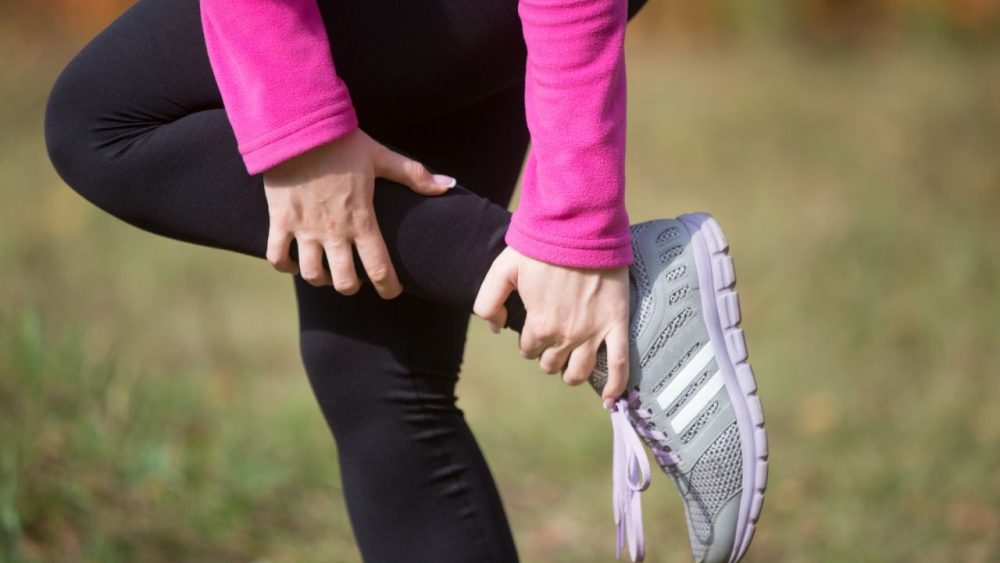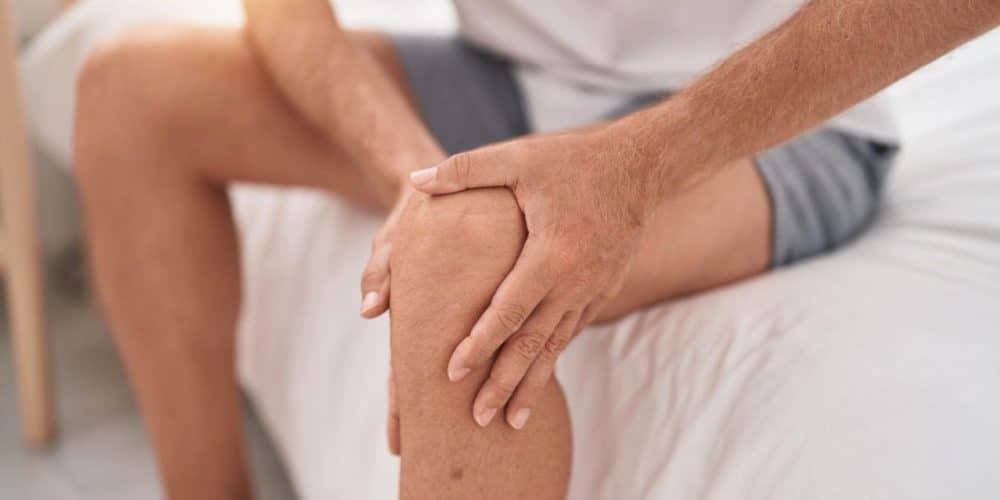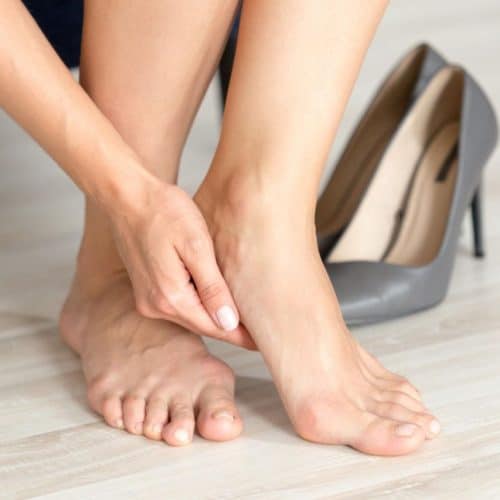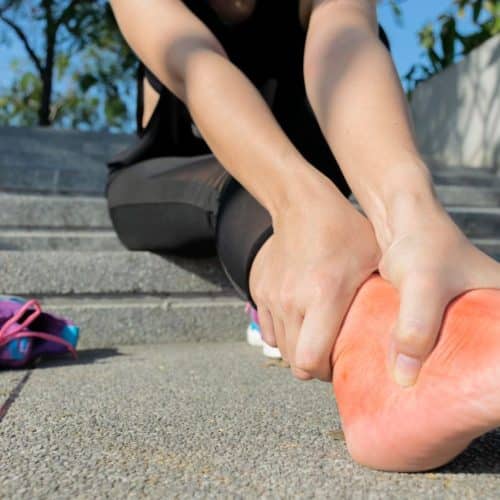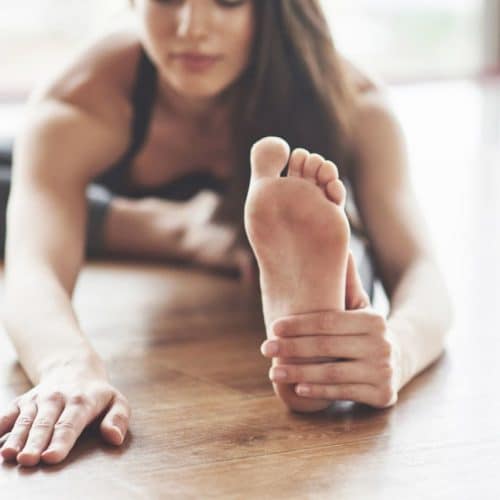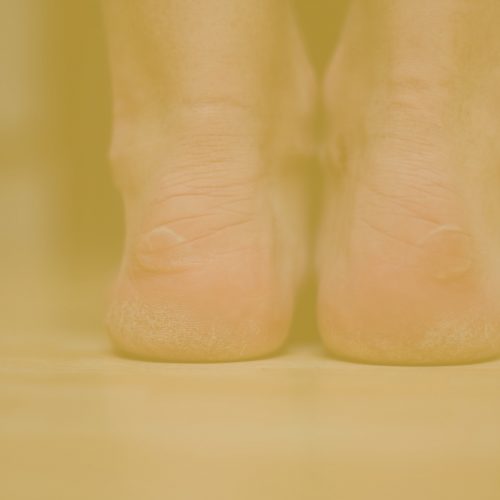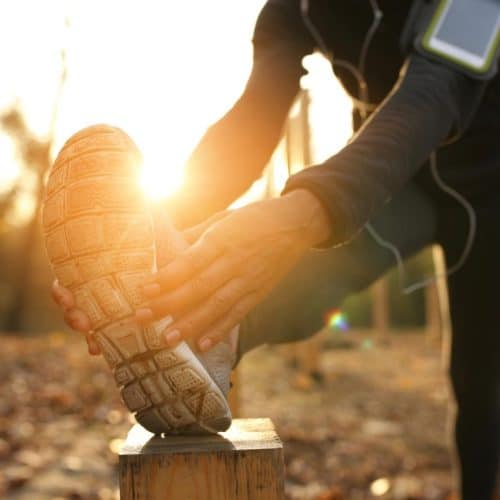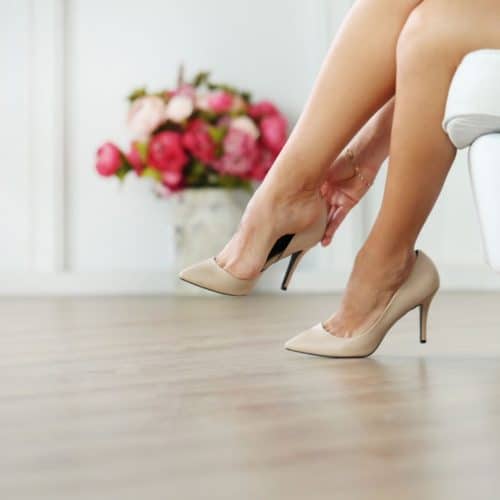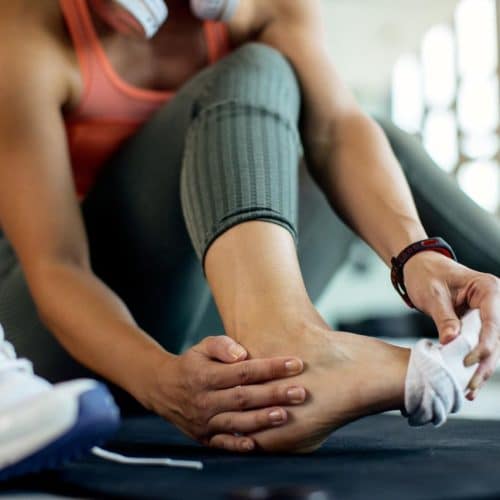Have you ever pushed yourself through a challenging workout only to be met with persistent knee pain afterwards? The discomfort might leave you wondering what could be causing this post-workout agony. Whether you’re a dedicated athlete or a casual fitness enthusiast, understanding the reasons behind knee pain after exercising is crucial for maintaining your physical well-being.
Knee discomfort is a common complaint among athletes and can be caused by a number of different circumstances. Incorrect technique when performing squats or lunges, which can put a strain on the knee joint, is a common cause of knee pain. In addition, overexertion not preceded by an appropriate warm-up or cool-down session can cause inflammation and discomfort in the body.
Knee pain can be caused by a variety of factors, including the terrain you work out on, the shoes you wear, and muscle imbalances. Exploring these factors sheds light on how to successfully avoid and treat knee pain; thus, it is important.
Curious to know more about safeguarding your knees during and after your workouts? Explore our comprehensive article to dive deeper into the intricacies of knee pain causes and prevention strategies. Discover proactive measures you can take to enhance your fitness routines and safeguard your knee joints, allowing you to continue pursuing your fitness goals without fear of discomfort or injury.
Understanding Knee Anatomy
The knee is an intricate and remarkable joint that supports our body weight and enables various movements. Comprehending its anatomy is essential for understanding the potential reasons behind knee pain after working out.
At its core, the knee joint is formed by the meeting of three main bones: the femur (thighbone), the tibia (shinbone), and the patella (kneecap). These bones are connected by ligaments, tendons, and muscles network, providing stability and flexibility.
- Ligaments: The knee is stabilised by four primary ligaments: the anterior cruciate ligament (ACL), the posterior cruciate ligament (PCL), the medial collateral ligament (MCL), and the lateral collateral ligament (LCL). These ligaments prevent excessive movement in different directions and keep the joint secure.
- Meniscus: Situated between the femur and tibia are two C-shaped pieces of cartilage known as the menisci. These act as shock absorbers, cushioning the impact during movement and distributing the forces evenly across the joint.
- Tendons: Tendons are tough, fibrous tissues that connect muscles to bones. The quadriceps tendon, for instance, connects the quadriceps muscles to the patella, allowing you to straighten your leg. Conversely, the patellar tendon connects the patella to the tibia, facilitating movements like jumping and kicking.
- Muscles: A network of muscles surrounds the knee joint, providing strength and control during movement. The quadriceps at the front of the thigh are responsible for extending the knee, while the hamstrings at the back of the thigh help flex the knee.
- Synovial Fluid: Inside the joint, a lubricating fluid called synovial fluid ensures smooth movement and reduces friction between the bones and other structures. This fluid nourishes the cartilage and keeps the joint well-lubricated.
The knee joint is subjected to various stresses and forces during exercise, especially during weight-bearing activities like running, jumping, and lifting. If these forces are not distributed evenly or if the joint is subjected to improper alignment, it can result in discomfort or pain.
Understanding the intricate interplay of bones, ligaments, tendons, muscles, and cartilage in the knee joint highlights the importance of caring for this complex structure during workouts. Doing so can minimise the risk of knee pain and injuries, allowing you to pursue your fitness journey with confidence and comfort.
The Importance of Warm-up and Cooldown
A workout routine is an excellent way to boost your physical fitness and overall well-being. However, to ensure a safe and effective exercise experience, paying attention to two crucial phases: the warm-up and the cool-down, is essential. These pre-and post-workout rituals might seem minor, but they significantly prevent knee pain and promote long-term joint health.
1. The Warm-Up
Consider the warm-up as your body’s way of easing into the upcoming physical demands. Here’s why it’s so important:
- Increased Blood Flow: A proper warm-up gradually increases your heart rate, directing more blood flow to your muscles. This enhanced circulation delivers oxygen and nutrients, preparing your muscles for upcoming challenges.
- Improved Muscle Function: Your muscles’ temperature rises as blood flow increases. This warmth makes your muscles more pliable and less prone to injury. It’s like preparing a rubber band for stretching – it’s more elastic and less likely to snap.
- Enhanced Joint Lubrication: Just as a car engine needs oil to run smoothly, your joints require synovial fluid for optimal functioning. A warm-up helps stimulate the production of this fluid, ensuring your joints move seamlessly during exercise.
- Mental Preparation: Beyond the physical benefits, a warm-up mentally prepares you for the workout ahead. It lets you focus, set your intentions, and get the mindset for a successful session.
A good warm-up should involve dynamic movements that mimic the exercises you’re about to perform. For example, start with leg swings and hip circles if your workout includes squats and lunges. Spend 5-10 minutes on your warm-up routine to reap its full benefits.
2. The Cooldown
Once you’ve completed your workout, don’t rush to leave the gym or stop exercising abruptly. The cool-down phase is equally important:
- Gradual Recovery: The cool-down allows your heart rate to return to its resting state gradually. Abruptly stopping intense exercise can lead to dizziness or even fainting. Slow down your pace and let your heart rate come down naturally.
- Waste Removal: During exercise, your muscles produce metabolic waste, such as lactic acid. A proper cool-down helps your body flush out these waste products, reducing the likelihood of muscle soreness.
- Flexibility Enhancement: Your muscles are warm and more receptive to stretching after exercising. Incorporate static stretches during your cool-down to enhance flexibility and maintain muscle balance.
- Mental Transition: The cool-down bridges the high-intensity workout and the post-exercise phase. It allows your mind to wind down, preventing abrupt shifts that might leave you tired or disoriented.
A typical cool-down includes 5-10 minutes of low-intensity movements followed by static stretching. Focus on the muscles you’ve engaged during your workout, holding each stretch for 15-30 seconds.
In the grand scheme of your fitness journey, the warm-up and cool-down seem like minor components. However, they’re like the foundation and roof of a sturdy house – they provide stability, protection, and longevity.
By dedicating a few extra minutes to these essential phases, you’re not only preventing knee pain but also setting the stage for a more productive and enjoyable workout experience. So, before diving into your next exercise routine, remember the importance of warming up and cooling down for your knees and your overall fitness success.
Overexertion and Strain
One of the common culprits behind knee pain after working out is overexertion and strain. It’s easy to get caught up in the enthusiasm of a workout session and push your limits, but doing so without proper consideration can lead to discomfort and injury. Let’s delve deeper into how overexertion and strain affect your knees and what you can do to prevent them.
1. The Mechanism of Overexertion
Imagine your body as a machine that needs time to warm up and operate efficiently. When you suddenly subject this machine to excessive stress without proper preparation, it’s like revving up an engine without letting it idle first. Overexertion occurs when you push your body beyond its current fitness level, overwhelming its capacity to adapt.
2. The Impact on Your Knees
Your knees are highly sensitive to overexertion due to their intricate structure and the significant role they play in weight-bearing activities. When you engage in intense exercises without gradually building up to them, the forces exerted on your knee joint can become too much to handle. This can lead to tissue microtrauma, resulting in pain and inflammation.
3. Identifying Overexertion-Related Knee Pain
Overexertion-related knee pain often presents as a dull ache or discomfort, which might worsen when you move or apply pressure. It can be accompanied by mild swelling and tenderness. It’s crucial not to ignore these signals from your body, as doing so might exacerbate the issue.
4. Prevention and Management
Preventing overexertion-related knee pain requires a combination of mindfulness and strategic planning:
- Gradual Progression: Avoid sudden spikes in workout intensity. Instead, gradually increase the duration and intensity of your exercises over time. This allows your body, including your knees, to adapt and strengthen.
- Listen to Your Body: Listen to how your body feels during workouts. If you experience any unusual discomfort or pain, don’t push through it. Instead, modify or stop the exercise to prevent further strain.
- Incorporate Rest Days: Rest days are essential for recovery. They give your body time to repair and rebuild, reducing the risk of overexertion-related injuries.
- Proper Warm-Up: A thorough warm-up routine prepares your muscles and joints for the challenges ahead. Gradually increasing your heart rate and blood flow primes your body for action.
- Stretching: Dynamic stretching before exercising and static stretching after can help maintain flexibility and reduce the risk of strain.
- Cross-Training: Incorporate various exercises into your routine to avoid overworking specific muscle groups and joints. This promotes overall balance and reduces the strain on your knees.
5. Recovery and Moving Forward
If you experience knee pain due to overexertion, the first step is to rest and allow your body to heal. Ice and elevation can help reduce inflammation. Once the pain subsides, consider consulting a fitness professional or physical therapist to adjust your workout routine and ensure proper form.
Incorrect Exercise Techniques
Mastering proper exercise techniques is a cornerstone of effective and injury-free workouts. Unfortunately, many individuals overlook the importance of correct form, leading to many issues, including knee pain. In this section, we’ll delve into the repercussions of incorrect exercise techniques on your knees and provide insights into how to ensure your movements are safe and beneficial.
1. The Consequences of Incorrect Form
Think of your body as a finely tuned instrument – each movement orchestrated precisely. When you perform exercises with improper form, you disrupt this harmonious symphony and introduce discord. Incorrect exercise techniques can significantly impact your knees due to the joint’s vulnerability to misalignment and uneven stress.
2. Understanding the Knee’s Vulnerability
The knee joint is designed to function optimally when the forces acting upon it are evenly distributed. Incorrect exercise techniques disrupt this equilibrium, leading to imbalances and overloading certain structures. The result? The unwanted strain on ligaments, tendons, and cartilage can culminate in pain and discomfort.
3. Identifying Incorrect Form-Related Knee Pain
A sharp or stabbing sensation often characterises knee pain stemming from incorrect exercise techniques during or after workouts. It might be accompanied by a feeling of instability or discomfort while walking. If you notice your knees hurting consistently during specific exercises, it’s time to assess your form.
4. Prevention and Correction
The good news is that preventing incorrect form-related knee pain is entirely within your control:
- Education: Prioritise learning the proper techniques for each exercise you incorporate into your routine. Resources such as fitness professionals, online tutorials, and instructional videos can be invaluable.
- Focus on Alignment: Whether squatting, lunging, or lifting weights, focus on maintaining proper alignment. This means keeping your knees aligned with your toes and avoiding excessive inward or outward movement.
- Mind-Muscle Connection: Concentrate on the muscles you’re engaging in during each exercise. This mental connection can help you engage the correct muscles and avoid compensatory movements that strain your knees.
- Use Mirrors: Exercising in front of a mirror allows you to monitor your form in real-time. This visual feedback can help you make immediate adjustments and establish correct movement patterns.
- Lighten the Load: Don’t prioritise lifting heavy weights over proper form. Start with lighter weights and gradually increase them as your form improves.
- Seek Professional Guidance: If you need more clarification about your technique, consider working with a fitness professional or personal trainer. They can provide personalised guidance and correct your form in real-time.
5. Rehabilitation and Moving Forward
If you’ve been exercising with incorrect form and are experiencing knee pain, the first step is to address the issue before it worsens. Rest your knees and consult a healthcare practitioner or physical therapist for guidance. They can help you rehabilitate and develop a plan to strengthen the muscles around your knees, improving their stability and reducing the risk of future injuries.
Improper Footwear Choice
Regarding exercise, the right footwear isn’t just a fashion statement – it’s crucial in protecting your knees and preventing pain. Choosing improper footwear can affect your overall body alignment, leading to discomfort and potential injuries. In this section, we’ll explore the significance of proper footwear and how it can make a difference in your workout experience.
1. The Role of Footwear in Knee Health
Your feet serve as the foundation for your entire body. How they interact with the ground and absorb shock can influence the alignment of your knees and the distribution of forces throughout your body. The wrong pair of shoes can disrupt this delicate balance, contributing to knee pain and even issues in other joints.
2. Impact on Knee Alignment
Imagine walking on a rocky surface wearing flimsy sandals – your feet would strain to find balance, causing misalignment and potential discomfort. Similarly, improper footwear can alter how your feet strike the ground during exercise, affecting your knee alignment and increasing the risk of pain.
3. Cushioning and Shock Absorption
Running, jumping, and even weightlifting subject your knees to significant impact forces. Proper workout shoes are designed with cushioning and shock absorption properties that reduce the stress on your joints, including your knees. Without this essential cushioning, your knees might bear the brunt of these impacts, leading to pain over time.
4. Stability and Support
Many exercises involve lateral movements or changes in direction, which require stability and support from your footwear. Inadequate shoes can lead to wobbling and instability, increasing the likelihood of missteps that put extra strain on your knees.
5. Identifying Footwear-Related Knee Pain
Knee pain stemming from improper footwear can manifest in various ways, including dull aches, soreness, or discomfort. You might notice that the pain worsens during or after certain exercises. Additionally, if you experience pain in other parts of your body, such as your hips or lower back, it could result from poor footwear affecting your overall body alignment.
6. Choosing the Right Footwear
Investing in the right pair of workout shoes can significantly enhance your knee health and overall exercise experience:
- Consider Activity: Different activities require different types of shoes. Running shoes, for instance, provide extra cushioning, while cross-training shoes offer lateral support.
- Proper Fit: Ensure your shoes fit snugly without being too tight. There should be enough room for your toes to move comfortably.
- Arch Support: Choose shoes with appropriate arch support based on your foot type – flat, neutral, or high arches.
- Cushioning: Look for shoes with ample cushioning to absorb impact forces and protect your knees.
- Brand and Quality: Opt for reputable brands known for their quality and focus on sports-specific footwear.
- Replace When Necessary: Shoes lose their cushioning and support over time. Replace them when you notice signs of wear and tear.
Your feet are the foundation of your body, and the shoes you wear during workouts play a pivotal role in supporting this foundation. By prioritising proper footwear that offers cushioning, stability, and support, you’re not only preventing knee pain but also promoting overall joint health and alignment. So, before you embark on your next exercise session, ensure you’re lacing up the right shoes – your knees will thank you.
Muscle Imbalances
Muscles work best when they operate harmoniously, supporting each other’s actions and maintaining balanced movement. However, when certain muscle groups overpower others, it can lead to muscle imbalances that affect your joints, particularly your knees. This section will delve into muscle imbalances, their role in knee pain, and how to address them for a healthier, pain-free workout experience.
1. Understanding Muscle Imbalances
Muscle imbalances occur when certain muscles become stronger and more dominant while others remain relatively weaker. This disparity can disrupt the synergy between muscle groups, leading to misalignment, inefficient movement, and knee pain.
2. The Impact on Knee Joints
When you exercise with muscular imbalances, some of your muscles may work too hard, while others don’t get enough stimulation from the workout. This can put abnormal stresses on the joints of your knee, leading to misalignment, instability, and soreness in the knee. These imbalances may, over time, play a role in the development of persistent knee discomfort.
3. Common Causes
Several factors contribute to the development of muscle imbalances:
- Sedentary Lifestyle: Prolonged sitting or inactivity can weaken muscles, particularly the glutes and core, which are crucial for maintaining proper alignment.
- Repetitive Movements: Repeating the same exercises without incorporating variety can lead to overdevelopment of certain muscles and neglect of others.
- Poor Posture: Bad posture can cause muscle imbalances, especially in the muscles responsible for maintaining a straight spine and proper alignment.
- Unilateral Movements: Focusing solely on one side of the body during exercises, like carrying heavy bags on one shoulder, can contribute to imbalances.
4. The Knee’s Vulnerability
The knees are particularly susceptible to muscle imbalances due to their central role in many movements. When imbalances pull the knee joint out of its natural alignment, it increases the stress on certain structures and predisposes the area to pain and discomfort.
5. Identifying Muscle Imbalance-Related Knee Pain
Muscle imbalance-related knee pain often presents as localised discomfort, which might be more pronounced during specific movements or exercises. You might also notice a feeling of weakness or instability in the knee joint.
6. Addressing Muscle Imbalances
Addressing muscle imbalances involves a multifaceted approach:
- Balanced Workout Routine: Incorporate exercises targeting different muscle groups. Avoid overworking certain muscles and neglecting others.
- Core Strengthening: A strong core provides stability and supports proper alignment. Include exercises that engage your abdominal and back muscles.
- Functional Movements: Incorporate functional movements that mimic real-life activities. These movements engage multiple muscle groups and promote balanced strength.
- Stretching and Flexibility: Regular stretching improves muscle flexibility, preventing tightness and contributing to imbalances.
- Cross-Training: Engage in cardio, strength training, and flexibility exercises to prevent overemphasising specific muscle groups.
- Professional Guidance: Consider working with a fitness professional or physical therapist to identify specific imbalances and develop a personalised plan to address them.
Pre-existing Conditions
Knee pain after working out can be particularly challenging for individuals with pre-existing conditions. Conditions like arthritis or previous knee injuries can exacerbate discomfort and require special consideration when exercising. This section will explore how pre-existing conditions can impact knee pain, strategies to manage them, and steps to ensure a safe and effective workout routine.
1. The Influence of Pre-existing Conditions
Pre-existing conditions such as arthritis, ligament injuries, or knee surgeries can alter the structure and function of your knee joint. These changes can make the joint more susceptible to pain and discomfort, especially during and after exercise.
2. Arthritis and Knee Pain
Arthritis is a common condition that causes inflammation and pain in the joints, including the knees. High-impact exercises or movements involving bending and twisting can exacerbate arthritis-related knee pain.
3. Previous Knee Injuries
If you’ve experienced a knee injury in the past, the affected area might be weaker or less stable. This can lead to compensatory movements, altering your gait and mechanics and potentially causing pain.
4. Strategies for Managing Pre-existing Conditions
While pre-existing conditions might pose challenges, they don’t necessarily mean you can’t engage in physical activity. With the right approach, you can manage your condition and minimise knee pain:
- Consult a Healthcare Practitioner: Before starting a new exercise routine, consult your healthcare practitioner or a physical therapist. They can provide guidance on safe exercises and modifications tailored to your condition.
- Low-Impact Exercises: Opt for low-impact activities like swimming, cycling, or using an elliptical machine. These activities minimise stress on the knees while providing cardiovascular benefits.
- Strengthening Exercises: Use targeted strength exercises to support the muscles around your knees. Strong muscles provide stability and help protect the joint.
- Balance and Flexibility: Include balance and flexibility exercises to improve joint mobility and prevent compensatory movements.
- Proper Form: Correct exercise form is crucial to avoid placing unnecessary stress on your knees. Focus on proper alignment and avoid movements that exacerbate your condition.
- Gradual Progression: Start with low intensity and gradually increase the duration and intensity of your workouts. This allows your body to adapt without overwhelming your joints.
5. Active Communication
When engaging in fitness activities with pre-existing conditions, communication is key:
- Inform Your Trainer: If you’re working with a fitness professional, inform them about your condition. They can tailor exercises to your needs and ensure your safety.
- Listen to Your Body: How your body responds to different movements. Stop and modify the exercise if you experience pain or discomfort.
- Be Patient: Progress might be slower for individuals with pre-existing conditions, and that’s okay. Patience and consistency are essential for gradual improvement.
Knee pain from pre-existing conditions can be managed with the right approach and guidance. You can maintain an active lifestyle while safeguarding your knee health by working closely with healthcare practitioners, incorporating safe and targeted exercises, and practising patience. Remember that your journey is unique, and with the right strategies, you can navigate knee pain and achieve your fitness goals while prioritising your overall well-being.
Tips to Prevent Knee Pain
Preventing knee pain requires a proactive approach encompassing various aspects of your workout routine, form, and overall lifestyle. By implementing the following tips, you can create a solid foundation for optimal knee health and enjoy pain-free workouts.
1. Gradual Progression
One of the golden rules of injury prevention is gradual progression. Take it slow, whether you’re starting a new exercise or increasing the intensity of your current routine. Gradually increase the duration, frequency, or weight to allow your body, including your knees, to adapt without being overwhelmed.
2. Focus on Proper Form and Posture
Exercising with the correct form is crucial for protecting your knees. Pay attention to your body’s alignment during each movement. Keep your knees in line with your toes and maintain a neutral spine. Engage your core muscles to provide stability and support for your knees.
3. Incorporate Low-Impact Exercises
While high-impact exercises can be effective, they can also place significant stress on your knees. Mix low-impact activities like swimming, cycling, and using an elliptical machine to prevent discomfort. These exercises provide cardiovascular benefits without excessive joint strain.
4. Invest in Supportive Footwear
Your choice of footwear can significantly impact your knee health. Invest in quality workout shoes with proper cushioning, support, and shock absorption. Ensure that the shoes fit well and provide stability during various movements.
5. Maintain Muscle Balance
Balanced muscle strength is essential for joint stability. Incorporate exercises that target all major muscle groups, especially those around the hips, thighs, and calves. This balanced approach prevents one muscle group from overpowering others and causing misalignment.
6. Warm Up and Cool Down
Always remember the power of a proper warm-up and cool-down. Gradually increase your heart rate and blood flow during warm-up to prepare your muscles and joints for exercise. After your workout, engage in light cardio and static stretches to aid recovery and prevent muscle tightness.
7. Hydrate and Nourish Your Body
Dehydration can contribute to muscle cramps and discomfort, including knee pain. Stay hydrated by drinking water throughout the day. Also, maintain a balanced diet rich in nutrients supporting joint health, such as omega-3 fatty acids, vitamin D, and antioxidants.
8. Listen to Your Body
Your body is your best guide. If you experience pain, discomfort, or unusual sensations during exercise, stop and assess the situation. Pushing through pain can worsen the issue. Modify the exercise or consult a fitness professional or healthcare practitioner if needed.
9. Mix Up Your Routine
Repetitive movements can lead to overuse injuries. To prevent knee pain, diversify your workout routine. Incorporate a mix of cardiovascular, strength training, and flexibility exercises. This variety prevents overloading specific muscle groups and reduces knee strain.
10. Rest and Recovery
Rest is an integral part of injury prevention. Allow your body sufficient time to recover between workouts. Overtraining can lead to inflammation and discomfort. Prioritise quality sleep, as it plays a vital role in muscle repair and overall well-being.
Conclusion
Many Australians have turned to regular exercise and working out to pursue a healthier and fitter lifestyle. While the benefits of physical activity are undeniable, it’s not uncommon to experience knee pain after exercising. Understanding the underlying causes of knee pain and taking proactive measures can help ensure a pain-free workout routine.
As you embark on your fitness journey, consider the impact of proper warm-up exercises on preventing knee pain. Share your favourite warm-up routine or exercise you find most effective in ensuring a pain-free workout experience. Your insights could inspire others to adopt new warm-up techniques and make their exercise routines more enjoyable.
Remember, knee pain might be a setback, but it doesn’t have to derail your fitness goals. By understanding the causes and taking proactive steps, Australians can continue to lead active lives without the hindrance of post-workout knee discomfort. Always consult a healthcare practitioner if the pain persists or worsens.
Content Summary
- Knee pain can be caused by a variety of factors, including the terrain you work out on, the shoes you wear, and muscle imbalances.
- Discover proactive measures you can take to enhance your fitness routines and safeguard your knee joints, allowing you to continue pursuing your fitness goals without fear of discomfort or injury.
- Comprehending its anatomy is essential for understanding the potential reasons behind knee pain after working out.
- Understanding the intricate interplay of bones, ligaments, tendons, muscles, and cartilage in the knee joint highlights the importance of caring for this complex structure during workouts.
- A workout routine is an excellent way to boost your physical fitness and overall well-being.
- However, to ensure a safe and effective exercise experience, paying attention to two crucial phases: the warm-up and the cool-down, is essential.
- Beyond the physical benefits, a warm-up mentally prepares you for the workout ahead.
- Spend 5-10 minutes on your warm-up routine to reap its full benefits.
- Incorporate static stretches during your cool-down to enhance flexibility and maintain muscle balance.
- In the grand scheme of your fitness journey, the warm-up and cool-down seem like minor components.
- Imagine your body as a machine that needs time to warm up and operate efficiently.
- Overexertion-related knee pain often presents as a dull ache or discomfort, which might worsen when you move or apply pressure.
- Avoid sudden spikes in workout intensity.
- Instead, gradually increase the duration and intensity of your exercises over time.
- This allows your body, including your knees, to adapt and strengthen.
- Listen to how your body feels during workouts.
- Mastering proper exercise techniques is a cornerstone of effective and injury-free workouts.
- Unfortunately, many individuals overlook the importance of correct form, leading to many issues, including knee pain.
- Incorrect exercise techniques can significantly impact your knees due to the joint’s vulnerability to misalignment and uneven stress.
- A sharp or stabbing sensation often characterises knee pain stemming from incorrect exercise techniques during or after workouts.
- Prioritise learning the proper techniques for each exercise you incorporate into your routine.
- If you’ve been exercising with incorrect form and are experiencing knee pain, the first step is to address the issue before it worsens.
- Rest your knees and consult a healthcare practitioner or physical therapist for guidance.
- Regarding exercise, the right footwear isn’t just a fashion statement – it’s crucial in protecting your knees and preventing pain.
- Choosing improper footwear can affect your overall body alignment, leading to discomfort and potential injuries.
- Proper workout shoes are designed with cushioning and shock absorption properties that reduce the stress on your joints, including your knees.
- Different activities require different types of shoes.
- By prioritising proper footwear that offers cushioning, stability, and support, you’re not only preventing knee pain but also promoting overall joint health and alignment.
- When you exercise with muscular imbalances, some of your muscles may work too hard, while others don’t get enough stimulation from the workout.
- The knees are particularly susceptible to muscle imbalances due to their central role in many movements.
- Muscle imbalance-related knee pain often presents as localised discomfort, which might be more pronounced during specific movements or exercises.
- Incorporate exercises targeting different muscle groups.
- Consider working with a fitness professional or physical therapist to identify specific imbalances and develop a personalised plan to address them.
- Knee pain after working out can be particularly challenging for individuals with pre-existing conditions.
- While pre-existing conditions might pose challenges, they don’t necessarily mean you can’t engage in physical activity.
- Before starting a new exercise routine, consult your healthcare practitioner or a physical therapist.
- If you’re working with a fitness professional, inform them about your condition.
- Knee pain from pre-existing conditions can be managed with the right approach and guidance.
- You can maintain an active lifestyle while safeguarding your knee health by working closely with healthcare practitioners, incorporating safe and targeted exercises, and practising patience.
- Take it slow, whether you’re starting a new exercise or increasing the intensity of your current routine.
- Exercising with the correct form is crucial for protecting your knees.
- Engage your core muscles to provide stability and support for your knees.
- Always remember the power of a proper warm-up and cool-down.
- Gradually increase your heart rate and blood flow during warm-up to prepare your muscles and joints for exercise.
- To prevent knee pain, diversify your workout routine.
- Understanding the underlying causes of knee pain and taking proactive measures can help ensure a pain-free workout routine.
- As you embark on your fitness journey, consider the impact of proper warm-up exercises on preventing knee pain.
FAQs
1. Is knee pain after working out normal?
It’s relatively common, but persistent or severe pain should be addressed with medical guidance.
2. Can I still exercise with knee pain?
It’s advisable to rest and consult a healthcare practitioner before resuming exercise.
3. How can I prevent knee pain during workouts?
Gradually increase intensity, maintain proper form, and ensure adequate warm-up and recovery.
4. Are there specific exercises to strengthen knee muscles?
Yes, exercises like leg raises, squats, and lunges can help strengthen the muscles around the knee.
5. When should I consider professional help for knee pain?
If pain is intense, persistent, or accompanied by other symptoms, consult a healthcare practitioner.


